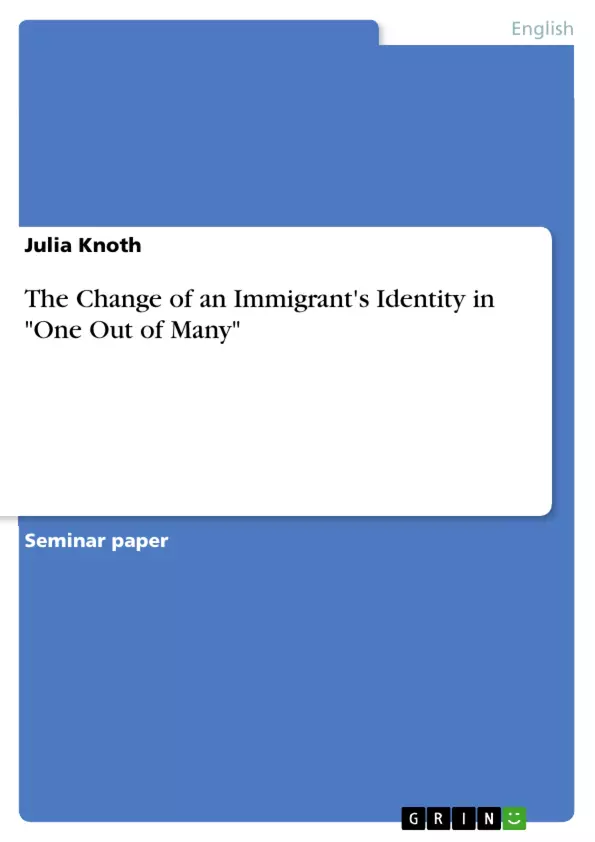In "One out of Many", written by V.S. Naipaul, Santosh emigrates from India to America and has to cope with the situation of being an illegal immigrant and finding a new identity. "One out of Many" is one of three short stories of the novel In a free state, first published in 1971.
The leading question that will be answered in the course of this paper is: How does Santosh‘s identity change when he emigrates from India to America? In this paper, I will attempt to show that, isolated from American society, Santosh remains a marginalized outsider who is torn between two cultures and has lost his roots. In order to examine the question of Santosh‘s identity, I will look at the narrator‘s perspective and its reflection of Santosh‘s situation in the first step. Secondly, Santosh‘s process of change will be described and analyzed thoroughly by looking at key scenes. The goal of describing a process brings the necessity of comparing his new life in America to his former life in India. This way, the focus will be on the changes Santosh makes. Describing his development in America, I will consider the way Santosh sees himself in India and I will find out how he assimilates to American culture. After Santosh‘s personal development, I will continue with Santosh‘s place in society, because the relations to other people are crucial when it comes to identity. At this point, the relation to different sub-cultures will be taken into consideration.
Table of Contents
- 1. Introduction
- 2. Reflection of Santosh's situation in the narrator's perspective
- 3. Santosh's life as an illegal immigrant
- 3.1 Santosh's development in America
- 3.2 Santosh's place in society
- 4. Conclusion
Objectives and Key Themes
This paper examines the changes in Santosh's identity as he immigrates from India to America, specifically focusing on his experience as an illegal immigrant and his struggle to find a new sense of belonging. The paper aims to analyze how Santosh's perception of himself and his place in society evolves within this context.
- The impact of cultural differences on identity formation
- The experience of being an outsider and the challenges of assimilation
- The role of memory and nostalgia in shaping identity
- The tension between individual aspirations and societal constraints
- The influence of the narrator's perspective on understanding Santosh's situation
Chapter Summaries
- Chapter 1: Introduction: This chapter introduces the main question explored in the paper, which is how Santosh's identity changes when he immigrates to America. The concept of identity is defined, focusing specifically on national identity. The paper also briefly summarizes the most relevant secondary literature on the topic, highlighting the contributions of Paula Morgan and Bruce King.
- Chapter 2: Reflection of Santosh's situation in the narrator's perspective: This chapter analyzes the narrative mode in "One Out of Many," focusing on the first-person perspective of the narrator and how this perspective shapes the reader's understanding of Santosh's experiences. The chapter highlights the importance of cultural differences and the outsider's perspective in understanding Santosh's position in American society.
- Chapter 3: Santosh's life as an illegal immigrant: This chapter delves into Santosh's experiences in America, examining his adaptation to a new culture and his personal development. The chapter explores how Santosh's perception of himself and his place in society changes as he confronts the challenges of being an immigrant.
Keywords
This paper explores key concepts such as immigrant identity, cultural assimilation, social marginalization, national identity, and the role of the narrator in shaping the reader's understanding of the protagonist's experience. These themes are analyzed through the lens of V.S. Naipaul's short story "One Out of Many," providing insights into the complex process of identity formation in a new cultural context.
- Citar trabajo
- Julia Knoth (Autor), 2013, The Change of an Immigrant's Identity in "One Out of Many", Múnich, GRIN Verlag, https://www.grin.com/document/423961



